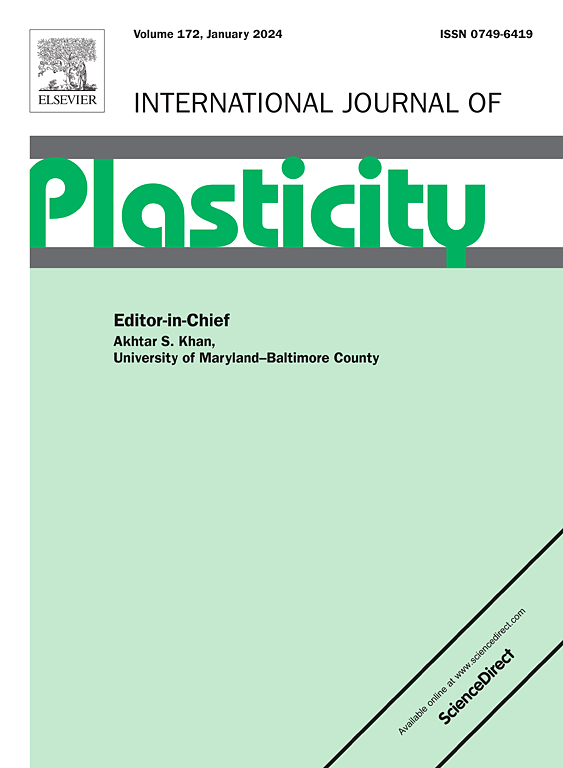A plasticity-induced internal length mean field model based on statistical analyses of EBSD and nanoindentation data
IF 9.4
1区 材料科学
Q1 ENGINEERING, MECHANICAL
引用次数: 0
Abstract
A new plasticity-induced internal length mean field model (ILMF) is developed, based on statistical analyses of geometrically necessary dislocation (GND) densities and total dislocation densities estimated from EBSD and nanoindentation data, respectively. It is applied to a single phase ferritic Al-killed steel, which plastically deforms with the occurrence of heterogeneous intra-granular fields. During tensile tests up to 18 % of overall plastic strain, the deformation maps of GND densities due to intra-granular plastic strain gradients are obtained together with nano-hardness maps. The Nye tensor (or dislocation density tensor) is calculated from the 2D EBSD orientations to estimate the intragranular GND density, while a mechanistic model is used to estimate the intragranular total dislocation density from nano-hardness measurements. These data are quantified as a function of the distance to grain boundaries (GBs) to study the development of such plastic strain gradients in the vicinity of GBs. The novel methodology lies in extracting the evolution law of a single plasticity-induced internal length, denoted , from the statistical analysis of GND and total dislocation densities spatial distribution. Hence, it is introduced as an evolving variable in an elastoviscoplastic self-consistent model (EVPSC) for a two-phase composite as a new internal mean field (ILMF) approach. Both experimentally quantified microstructural internal lengths defined by the mean grain size and the evolving layer , are considered to more realistically describe the macroscopic and phase response in terms of stress, GND density evolution and total dislocation density in each phase. An experiment/model comparison is also discussed regarding GND density evolution with plastic deformation.
基于 EBSD 和纳米压痕数据统计分析的塑性诱导内长平均场模型
基于几何必要位错(GND)密度和纳米压痕数据估计的总位错密度的统计分析,建立了一个新的塑性诱导内长度平均场模型(ILMF)。该方法应用于单相铁素体al淬火钢,该钢随非均匀晶内场的出现而发生塑性变形。在高达总塑性应变18%的拉伸试验中,由于颗粒内塑性应变梯度,GND密度的变形图与纳米硬度图一起得到。从二维EBSD取向计算Nye张量(或位错密度张量)来估计晶内GND密度,而从纳米硬度测量中使用力学模型来估计晶内总位错密度。这些数据被量化为到晶界距离的函数,以研究晶界附近塑性应变梯度的发展。该方法通过对总位错密度空间分布的统计分析,提取单个塑性诱导内长度λ的演化规律。因此,它作为一个演化变量被引入到两相复合材料的弹粘塑性自洽模型(EVPSC)中,作为一种新的内平均场(ILMF)方法。由平均晶粒尺寸和演化层λ定义的实验量化的微观组织内部长度被认为更真实地描述了从应力、GND密度演化和各相总位错密度方面的宏观和相响应。还讨论了塑性变形下地地密度的实验/模型比较。
本文章由计算机程序翻译,如有差异,请以英文原文为准。
求助全文
约1分钟内获得全文
求助全文
来源期刊

International Journal of Plasticity
工程技术-材料科学:综合
CiteScore
15.30
自引率
26.50%
发文量
256
审稿时长
46 days
期刊介绍:
International Journal of Plasticity aims to present original research encompassing all facets of plastic deformation, damage, and fracture behavior in both isotropic and anisotropic solids. This includes exploring the thermodynamics of plasticity and fracture, continuum theory, and macroscopic as well as microscopic phenomena.
Topics of interest span the plastic behavior of single crystals and polycrystalline metals, ceramics, rocks, soils, composites, nanocrystalline and microelectronics materials, shape memory alloys, ferroelectric ceramics, thin films, and polymers. Additionally, the journal covers plasticity aspects of failure and fracture mechanics. Contributions involving significant experimental, numerical, or theoretical advancements that enhance the understanding of the plastic behavior of solids are particularly valued. Papers addressing the modeling of finite nonlinear elastic deformation, bearing similarities to the modeling of plastic deformation, are also welcomed.
 求助内容:
求助内容: 应助结果提醒方式:
应助结果提醒方式:


